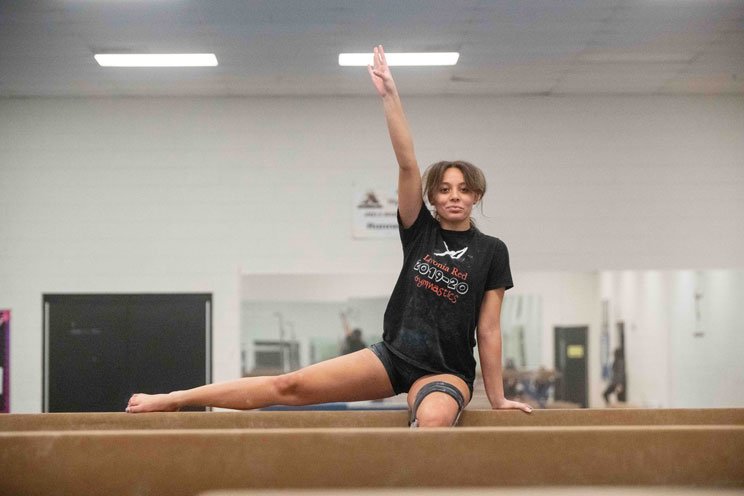Gymnastics Injuries
 At Henry Ford Health, our sports medicine specialists understand the unique physical demands of gymnastics, as well as the high risk of injuries. We provide elite-level care for gymnasts of all ages and skill levels, helping you get back to your sport safely.
At Henry Ford Health, our sports medicine specialists understand the unique physical demands of gymnastics, as well as the high risk of injuries. We provide elite-level care for gymnasts of all ages and skill levels, helping you get back to your sport safely.
Gymnastics injury causes
Gymnasts combine explosive strength with extreme flexibility to perform everything from floor routines to vaults. Hard landings from tumbling passes and dismounts put a great deal of stress on their knees, ankles and hips.
Unlike other athletes, gymnasts bear weight on their upper bodies as much as their lower bodies. Handstands, handsprings, vaulting and bar routines often give rise to hand, wrist and shoulder injuries.
Gymnastics is also a body-conscious sport. Athletes train for long periods of time each day and may be encouraged to keep their body weight low. Sometimes they don’t get the nutrients and calories they need. An inadequate diet can lead to weak bones and low muscle mass, increasing the risk of many injuries, such as stress fractures.
Common gymnastics injuries we treat
The ever-increasing skill level of gymnastics means injuries are more common than ever. At Henry Ford, we treat a wide range of gymnastics injuries, including:
- Ankle and knee sprains
- Anterior cruciate ligament (ACL) tears
- Concussions
- Elbow dislocations
- Exertional compartment syndrome (muscles in the arms or legs can’t expand during exercise, causing pain)
- SLAP tears (occurs where the top of your shoulder meets your bicep)
- Spondylolysis (stress fractures in the spine) and tibial stress fractures
- Wrist fractures
Gymnastics injury treatment
Our sports medicine specialists use a variety of techniques to treat gymnastics injuries, including:
- Injury protection: We start your treatment plan by protecting the injured area so you don’t sustain more damage. This might include splinting or bracing.
- Pain control: We may recommend ice and heat therapy, in addition to pain management treatments. Ultrasound therapy relaxes muscles and stimulates healing. Electrical stimulation reduces the amount of pain you feel by interrupting pain signals from your nerves to your brain.
- Strength and conditioning: We help you gradually recondition weak areas and regain range of motion. Improving your core and back strength can take pressure off overstressed joints. We also provide techniques to avoid overstretching or over-rotating during routines and landings.
- Blood flow restriction therapy: We use a cuff or elastic band on your arm or leg as you exercise and rehabilitate. The cuff reduces blood flow to an injured area. This technique strengthens muscles by forcing them to work harder to pump blood, without the stress of external weights.
- Proprioceptive training: We focus on proprioception — the sense of position and movement — when treating gymnastics injuries. If a gymnast’s sense of balance is off, they will continue to land incorrectly and re-injure themselves. Physical therapists provide exercises to improve balance and stability.
Most gymnastics injuries do not require surgery. But complex injuries that do not respond to conservative treatments may need more specialized care. Our orthopedic surgeons specialize in a range of minimally invasive procedures that help you heal with less pain and less down time.
Gymnastics injury prevention
These strategies can help improve your performance and prevent injuries:
- Stick to a balanced meal plan that’s rich in vitamins and nutrients, including protein, calcium and vitamin D.
- Commit to preseason conditioning that includes cross-training (non-gymnastics activities), such as low-impact cardio and strength training.
- Talk with a behavioral health specialist if you’re experiencing stress, fear or anxiety related to your sport.
- Use spotters and safety harnesses when learning new skills and stunts.
Gymnastics injury care: Why choose Henry Ford?
Highlights of our sports medicine program include:
- Convenient access: Most providers can see you within 24 to 48 hours, so you receive prompt care for your injury. We offer in-person and virtual appointments. Henry Ford also features walk-in orthopedic clinics with extended evening hours to fit your busy schedule.
- Minimally invasive treatment options: From Tenex procedures to treat Achilles and Patellar tendons to plasma-rich protein (PRP) injections to treat knee injuries there are options available to reduce procedure time, hasten recovery and increase potential for improved outcomes.
- Skilled team: Our expert team includes sports medicine physicians, orthopedic surgeons and certified athletic trainers. We stay up to date on the latest research and treatment techniques for gymnastics injuries, so you receive the highest quality care.
- Whole-athlete care: Performing in a highly competitive sport requires peak physical and mental health. We collaborate with physical therapists, dietitians, behavioral health specialists and other providers to ensure gymnasts get the complete care they need.
Explore our blogs
Learn more about gymnastics injuries:
- Preventing Sports Injuries in Your Student Athlete
- The Dangers of Returning to a Sport Too Soon After an Injury
- What to Feed Your Student Athlete Before and After the Game

.svg?iar=0&hash=F6049510E33E4E6D8196C26CCC0A64A4)

/hfh-logo-main--white.svg?iar=0&hash=ED491CBFADFB7670FAE94559C98D7798)